20.2 The Sum and Difference Formulas
Formulas for sin( α + β)
sin( α + β) and cos( α + β)cos( α + β) • Formulas for sin( α − β)sin( α − β) and cos( α − β)cos( α − β) • Formulas for tan( α + β)tan( α + β) and tan( α − β)tan( α − β)
There are other important relations among the trigonometric functions. The most important and useful relations are those that involve twice an angle and half an angle. To obtain these relations, in this section, we derive the expressions for the sine and cosine of the sum and difference of two angles. These expressions will lead directly to the desired relations of double and half angles that we will derive in the following sections.
Equation (12.13), shown in the margin, gives the polar (or trigonometric) form of the product of two complex numbers. We can use this formula to derive the expressions for the sine and cosine of the sum and difference of two angles.
Using Eq. (12.13) to find the product of the complex numbers cos α + j sin α
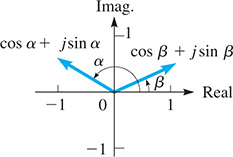
Fig. 20.6
Expanding the left side, and then switching sides, we have
Because two complex numbers are equal if their real parts are equal and their imaginary parts are equal, we have the following formulas:
EXAMPLE 1 Verifying the sin(α + β) formula
Verify that sin 90 ° = 1 ,
CAUTION
It should be obvious from this example that sin(α + β)
EXAMPLE 2 Using cos(α + β) with numerical values
Given that sin α = 513
Because sin α = 513
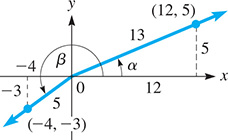
Fig. 20.7
Then, by using Eq. (20.10), we have
From Eqs. (20.9) and (20.10), we can easily find expressions for sin(α − β)
Because cos( − β) = cos β
In the same manner, we find that
EXAMPLE 3 Using cos(α − β) formula
Find cos 15 °
EXAMPLE 4 sin(α − β) formula—oscillating spring
In analyzing the motion of an object oscillating up and down at the end of a spring, the expression sin(ωt + α) cos α − cos(ωt + α) sin α
If we let x = ωt + α ,
EXAMPLE 5 Using cos(α + β) formula
Evaluate cos 23 ° cos 67 ° − sin 23 ° sin 67 ° .
We note that this expression fits the form of the right side of Eq. (20.10), so
Again, we are able to evaluate this expression by recognizing the form of the given expression. Evaluation by a calculator will verify the result.
By dividing the right side of Eq. (20.9) by that of Eq. (20.10), we can determine expressions for tan(α + β) ,
The formula for tan(α + β)
Certain trigonometric identities can be proven by the formulas derived in this section. The following examples illustrate this use of these formulas.
EXAMPLE 6 Sin(α + β)—calculator verification
Prove that sin(180 ° + x) = − sin x .
Although x may or may not be an acute angle, this agrees with the results for the sine of a third-quadrant angle as discussed in Section 8.2. See Fig. 20.8. The calculator check of this identity, with y1 = sin(π + x)
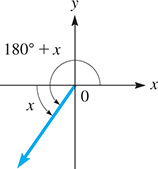
Fig. 20.8
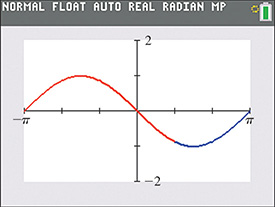
Fig. 20.9
EXAMPLE 7 Proving a trig identity with tan(α ± β)
Show that tan(α + β) tan(α − β) = tan2 α − tan2 β1 − tan2 αtan2 β .
Using both of Eqs. (20.13), we have
EXAMPLE 8 Trig identity using sin(α − β)
Simplify the expression sin(α − β)sin α sin β .
EXAMPLE 9 Using sin(α − β)—three-phase generator
Alternating electric current is produced essentially by a coil of wire rotating in a magnetic field, and this is the basis for designing generators of alternating current. A three-phase generator uses three coils of wire and thereby produces three electric currents at the same time. This is the most widely used type of polyphase generator as mentioned in the chapter introduction on page 535.
The voltages induced in a three-phase generator can be represented as
where E0
Setting up the sum E1 + E2 + E3
To show that E1 + E2 + E3 = 0
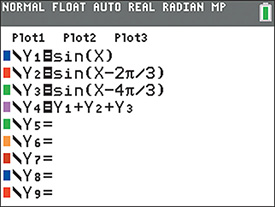
Fig. 20.10
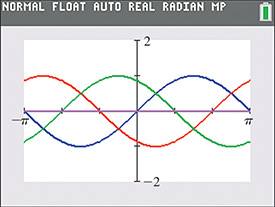
Fig. 20.11
EXERCISES 20.2
In Exercises 1 and 2, make the given changes in the indicated examples of this section and then solve the given problems.
In Example 2, change 513
513 to 12131213 and then find the value of cos(α + β) .cos(α + β) . In Example 6, change 180 ° + x
180 ° + x to 180 ° − x180 ° − x and then determine what other changes result.
In Exercises 3–6, determine the values of the given functions as indicated.
Find sin 105 °
sin 105 ° by using 105 ° = 60 ° + 45 ° .105 ° = 60 ° + 45 ° . Find tan 75 °
tan 75 ° by using 75 ° = 30 ° + 45 ° .75 ° = 30 ° + 45 ° . Find cos 15 °
cos 15 ° by using 15 ° = 60 ° − 45 ° .15 ° = 60 ° − 45 ° . Find sin 15 °
sin 15 ° by using 15 ° = 225 ° − 210 ° .15 ° = 225 ° − 210 ° .
In Exercises 7–10, evaluate the given functions with the following information: sin α = 4/5
sin(α + β)
sin(α + β) tan(β − α)
tan(β − α) cos(α + β)
cos(α + β) sin(α − β)
sin(α − β)
In Exercises 11–20, simplify the given expressions.
sin x cos 2x + sin 2x cos x
sin x cos 2x + sin 2x cos x sin 3x cos x − sin x cos 3x
sin 3x cos x − sin x cos 3x cos 5x cos x + sin 5x sin x
cos 5x cos x + sin 5x sin x tan(x − y) + tan x1 − tan(x − y) tan y
tan(x − y) + tan x1 − tan(x − y) tan y sin(90 ° − x)
sin(90 ° − x) cos(32 π − x)
cos(32 π − x) tan(x − π)
tan(x − π) sin(x + π / 2)
sin(x + π / 2) sin 3x cos(3x − π) − cos 3x sin(3x − π)
sin 3x cos(3x − π) − cos 3x sin(3x − π) cos(x + π) cos(x − π) + sin(x + π) sin(x − π)
cos(x + π) cos(x − π) + sin(x + π) sin(x − π)
In Exercises 21–24, evaluate each expression by first changing the form. Verify each by use of a calculator.
sin 122 ° cos 32 ° − cos 122 ° sin 32 °
sin 122 ° cos 32 ° − cos 122 ° sin 32 ° cos 250 ° cos 70 ° + sin 250 ° sin 70 °
cos 250 ° cos 70 ° + sin 250 ° sin 70 ° cosπ5 cos3π10 − sinπ5 sin3π10
cosπ5 cos3π10 − sinπ5 sin3π10 tanπ10 + tan3π201 − tanπ10 tan3π20
tanπ10 + tan3π201 − tanπ10 tan3π20
In Exercises 25–28, prove the given identities.
sin(x + y) sin(x − y) = sin2 x − sin2 y
sin(x + y) sin(x − y) = sin2 x − sin2 y cos(x + y) cos(x − y) = cos2 x − sin2 y
cos(x + y) cos(x − y) = cos2 x − sin2 y cos(α + β) + cos(α − β) = 2 cos α cos β
cos(α + β) + cos(α − β) = 2 cos α cos β  tan(90 ° + x) = − cot x
tan(90 ° + x) = − cot xtan(90 ° + x) = − cot x [Explain why Eq. (20.13) cannot be used for this, but Eqs. (20.9) and (20.10) can be used.]
In Exercises 29–32, verify each identity by comparing the graph of the left side with the graph of the right side on a calculator.
cos(π6 + x) = √3 cos x − sin x2
cos(π6 + x) = 3–√ cos x − sin x2 sin(120 ° − x) = √3 cos x + sin x2
sin(120 ° − x) = 3–√ cos x + sin x2 tan(3π4 + x) = tan x − 1tan x + 1
tan(3π4 + x) = tan x − 1tan x + 1 cos(π2 − x) = sin x
cos(π2 − x) = sin x
In Exercises 33–36, derive the given equations as indicated. Equations (20.14)–(20.16) are known as the product formulas.
By dividing the right side of Eq. (20.9) by that of Eq. (20.10), and dividing the right side of Eq. (20.11) by that of Eq. (20.12), derive Eq. (20.13).
tan(α ± β) = tan α ± tan β1 ∓ tan α tan β(20.13)tan(α ± β) = tan α ± tan β1 ∓ tan α tan β (Hint: Divide numerator and denominator by cos α cos β .
cos α cos β . )By adding Eqs. (20.9) and (20.11), derive the equation
sin α cos β = 12[ sin(α + β) + sin(α − β)](20.14)sin α cos β = 12[ sin(α + β) + sin(α − β)] By adding Eqs. (20.10) and (20.12), derive the equation
cos α cos β = 12 [ cos(α + β) + cos(α − β)](20.15)cos α cos β = 12 [ cos(α + β) + cos(α − β)] By subtracting Eq. (20.10) from Eq. (20.12), derive
sin α sin β = 12[ cos(α − β) − cos(α + β)](20.16)sin α sin β = 12[ cos(α − β) − cos(α + β)]
In Exercises 37–40, derive the given equations by letting α + β = x
Use Eq. (20.14) and the substitutions above to derive the equation
sin x + sin y = 2 sin12 (x + y) cos12 (x − y)(20.17)sin x + sin y = 2 sin12 (x + y) cos12 (x − y) Use Eqs. (20.9) and (20.11) and the substitutions above to derive the equation
sin x − sin y = 2 sin12 (x − y) cos12 (x + y)(20.18)sin x − sin y = 2 sin12 (x − y) cos12 (x + y) Use Eq. (20.15) and the substitutions above to derive the equation
cos x + cos y = 2 cos12 (x + y) cos12 (x − y)(20.19)cos x + cos y = 2 cos12 (x + y) cos12 (x − y) Use Eq. (20.16) and the substitutions above to derive the equation
cos x − cos y = − 2 sin12 (x + y) sin12 (x − y)(20.20)cos x − cos y = − 2 sin12 (x + y) sin12 (x − y)
In Exercises 41–54, solve the given problems.
Evaluate exactly: sin(x + 30 ° ) cos x − cos(x + 30 ° ) sin x
sin(x + 30 ° ) cos x − cos(x + 30 ° ) sin x Simplify: sin(π6 − θ) + cos(π3 − θ)
sin(π6 − θ) + cos(π3 − θ) Show that sin 2xsin x = 2 cos x .
sin 2xsin x = 2 cos x . [Hint: sin 2x = sin(x + x) .sin 2x = sin(x + x) . ]Using graphs displayed on a calculator, verify the identity in Exercise 43.
 Explain how the exact value of sin 75 °
Explain how the exact value of sin 75 ° sin 75 ° can be found using either Eq. (20.9) or Eq. (20.11).A vertical pole of length L is placed on top of a hill of height h. From the plain below the angles of elevation of the top and bottom of the pole are α
α and β .β . See Fig. 20.12. Show that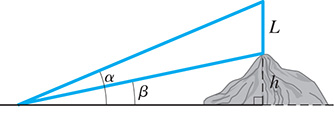
Fig. 20.12
h = Lcos α sin βsin(α − β)h = Lcos α sin βsin(α − β) The design of a certain three-phase alternating-current generator uses the fact that the sum of the currents Icos(θ + 30 ° ) , Icos(θ + 150 ° ) ,
Icos(θ + 30 ° ) , Icos(θ + 150 ° ) , and Icos(θ + 270 ° )Icos(θ + 270 ° ) is zero. Verify this.The current (in A) in a certain AC circuit is given by i = 4 sin(120πt + π2) .
i = 4 sin(120πt + π2) . Use the sum formula for sine to write this in a different form and then simplify.For voltages V1 = 20 sin 120πt
V1 = 20 sin 120πt and V2 = 20 cos 120πt ,V2 = 20 cos 120πt , show that V = V1 + V2 = 20√2 sin(120πt + π / 4) .V = V1 + V2 = 202–√ sin(120πt + π / 4) . Use a calculator to verify this result.The displacements y1
y1 and y2y2 of two waves traveling through the same medium are given by y1 = Asin 2π(t / T − x / λ)y1 = Asin 2π(t / T − x / λ) and y2 = Asin 2π(t / T + x / λ) .y2 = Asin 2π(t / T + x / λ) . Find an expression for the displacement y1 + y2y1 + y2 of the combination of the waves.The displacement d of a water wave is given by the equation d = d0sin(ωt + α) .
d = d0sin(ωt + α) . Show that this can be written as d = d1sin ωt + d2cos ωt ,d = d1sin ωt + d2cos ωt , where d1 = d0cos αd1 = d0cos α and d2 = d0sin α .d2 = d0sin α . A weight w is held in equilibrium by forces F and T as shown in Fig. 20.13. Equations relating w, F, and T are
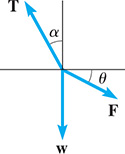
Fig. 20.13
Fcos θ = T sin αw + Fsin θ = T cos αShow that w = Tcos(θ + a)cos θ .Fcos θw + Fsin θShow that w = = = T sin αT cos αTcos(θ + a)cos θ . For the two bevel gears shown in Fig. 20.14, the equation tan α = sin βR + cos βis used .
tan α = sin βR + cos βis used . 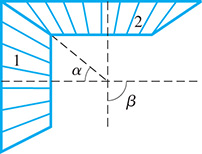
Fig. 20.14
Here, R is the ratio of gear 1 to gear 2. Show that
R = sin(β − α)sin α .R = sin(β − α)sin α . In the analysis of the angles of incidence i and reflection r of a light ray subject to certain conditions, the following expression is found:
E2(tan rtan i + 1) = E1(tan rtan i − 1)Show that E2 = E1 sin(r − i)sin(r + i) .E2(tan rtan i + 1) = E1(tan rtan i − 1)Show that E2 = E1 sin(r − i)sin(r + i) .
Answers to Practice Exercises
1
tan x
